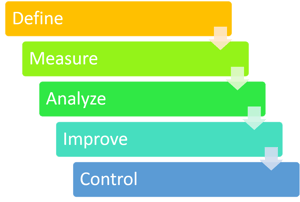 DMAIC (pronounced də-MAY-ick) is a data-driven technique used to improve processes. It is a key tool of the Six Sigma methodology, but it can be implemented as a standalone improvement method or as part of other process initiatives like Lean.
DMAIC (pronounced də-MAY-ick) is a data-driven technique used to improve processes. It is a key tool of the Six Sigma methodology, but it can be implemented as a standalone improvement method or as part of other process initiatives like Lean.
The technique is simple, yet powerful. It brings structure to the improvement process and helps teams explore potential solutions, decide a course of action, and implement process controls in short order.
Trying any new improvement strategy can be intimidating, so we thought it would be helpful to break down all the details of DMAIC so that you can give it a try with confidence.
What is DMAIC?
DMAIC is an acronym for Define, Measure, Analyze, Improve, and Control. The five steps represent an improvement cycle that is meant to be repeated frequently in an effort to identify best practices and move ever closer to perfect processes.
Define
The process kicks off with a clear statement of the target business problem and the scope of the intended improvements. The current state is documented in great detail as is the problem to be solved. At this point, teams also determine the objectives of improvement and map out what success looks like. Some organizations use formal project charters at the outset of a DMAIC cycle, while others are less formal. Ample documentation and detail are essential nevertheless.
Measure
As we mentioned, DMAIC is a data-driven approach to improvement. That means that you need to have baseline measurements that can be compared to post-improvement results. Quantifiable process effectiveness measurements might include the number of defects, process duration, process cost, or other relevant metrics. One or more members of the team should be assigned the responsibility for measurement, and the team should agree on how frequently the measurement will take place.
Analyze
Now that the team is armed with data, a root-cause analysis is performed to determine the underlying reason(s) for the business problem. Many organizations find that the 5 Whys technique is a helpful way to structure the process. Process maps are also popular. It is important to remember that many problems have more than one root-cause. Keeping attention on the causes, not the symptoms, helps make solutions more apparent and reduces the tendency to become defensive or to blame people, rather than processes.
Improve
It is essential to fight the urge to leap to the Improve stage. Proposed improvements should be implemented only after careful measurement and thoughtful analysis. There is an element of experimentation in DMAIC, but it should be tempered with good data and sound logic. Any risks associated with the improvement should be identified and communicated, along with the steps taken to mitigate those risks. Everyone should be on the lookout for unintended consequences so that action can be taken swiftly.
Control
The final step in a DMAIC cycle is Control. It is an essential piece of the equation that is often missing when improvement work occurs without structure. Control is about making sure that successful improvements don’t degrade over time. At this point, teams verify measurable improvement and determine if the improvements as implemented have achieved the project goals. They also update Standard Work documentation and look for other ways to integrate the lessons that have been learned.
How is DMAIC deployed?
In some cases, people work on a DMAIC project along with all of their other daily responsibilities. This is a great approach if a problem is important but not urgent, or if it will take a long time to solve. In other cases, a Kaizen or rapid improvement event is used. When that happens, project team members are relieved of their other responsibilities to focus solely on the DMAIC project. This is a good choice when a problem is urgent and when it is reasonable to expect a resolution in three to five days.
When Should DMAIC be Used?
DMAIC is used to improve current processes. It is an excellent choice whenever there is a complex problem with unclear root-causes or if the risks of inaction are high. Because DMAIC brings discipline to the improvement process and discourages teams from jumping over important steps, it increases the chances of success. DMAIC or another structured improvement cycle (see PDSA) should be used for most important projects.
What Tools Are Used for DMAIC?
Many continuous improvement tools and techniques can be helpful during a DMAIC project. Value stream maps, A3s, fishbone diagrams, and Catchball can all be of great use. Continuous improvement software is also a must for DMAIC. It helps structure the effort, improve communications, collect related documents, calculate results, and preserve the record of the project.
In short, DMAIC is an effective way to improve improvement. If you want projects to flow smoothly, find lasting solutions to difficult problems, and obtain measurable results, DMAIC is an excellent approach.

![[Watch Now] How to Leverage Lean for Long-Term Success](https://no-cache.hubspot.com/cta/default/326641/eb5ac7b8-b040-48b7-810e-1589561ffff9.png)


Add a Comment